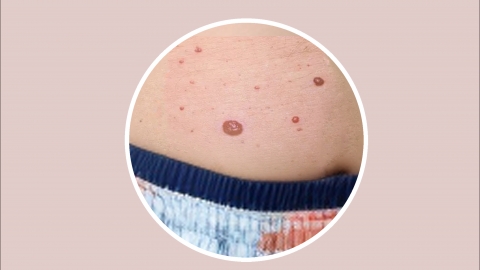Why do hemangiomas become hard?
Generally, vascular hemangiomas may become hardened due to reasons such as thrombus formation within the tumor, fibrous tissue proliferation, localized infection, chronic inflammation, or calcification. It is recommended to seek timely medical attention, identify the underlying cause, and undergo symptomatic treatment under a doctor's guidance. Detailed explanations are as follows:

1. Thrombus formation within the tumor: Blood flow within a hemangioma may be slow, making it prone to clotting and forming a thrombus. After thrombus organization, the texture of the tumor becomes harder, and hard nodules may be palpable, accompanied by mild local distension and pain, and the surface color may darken. Avoid squeezing or rubbing the tumor to prevent thrombus enlargement. Appropriate local heat application can be performed to promote blood circulation. If necessary, medications such as Venoruton tablets, Diosmin tablets, or Heparin Sodium Ointment may be used as directed by a physician to improve circulation and reduce the degree of thrombus organization.
2. Fibrous tissue proliferation: In cases of long-standing hemangiomas, vascular endothelial cell proliferation slows down, and fibrous tissue gradually replaces the vascular components, causing the tumor to harden and its growth to slow. There are often no significant symptoms, only changes in texture. Regular observation of the tumor's size and hardness changes is recommended, along with avoiding repeated irritation and maintaining local skin cleanliness. If fibrous tissue proliferation progresses rapidly, medications such as Asiaticoside Cream, Mucopolysaccharide Polysulfate Cream, or Compound Heparin Sodium Allantoin Gel may be applied under medical guidance to soften the tissue and delay the hardening process.
3. Local infection: Bacterial invasion of the hemangioma and surrounding tissues may cause infection. Inflammatory stimulation leads to tissue congestion and edema, resulting in increased firmness, accompanied by local redness, swelling, and pain. Severe cases may lead to fever. Keep the affected area clean and dry, avoid contact with water, and use antibiotics such as Mupirocin Ointment, Fusidic Acid Cream, or Cefaclor Capsules as directed by a physician to control the infection. Once the inflammation is controlled, the tumor's hardness may gradually subside.
4. Chronic inflammation: Repeated friction or pressure on the hemangioma can trigger chronic inflammation. Prolonged inflammation causes excessive fibrous tissue proliferation, resulting in tumor hardening, thickened skin, pigmentation, and occasional dull pain. Reduce stimulation to the tumor area, wear loose clothing to avoid friction, and use medications such as Desonide Cream, Mometasone Furoate Cream, or Loratadine Tablets as directed by a physician to reduce the inflammatory response and inhibit excessive fibrous tissue proliferation.
5. Calcification: Due to ischemia, metabolic abnormalities, or other causes, calcium deposits may form calcified foci within the hemangioma, causing significant hardening of the tumor, feeling as hard as bone upon palpation, without tenderness. Expansion of the calcified areas may affect the movement of surrounding tissues. Avoid strenuous activity to prevent injury to the calcified area, and have regular follow-up examinations to monitor calcification changes. If the calcified focus compresses surrounding tissues, surgical removal of the hemangioma containing the calcified lesion may be performed under medical guidance to relieve the compression and improve local function.
In daily life, it is important to protect the area with the hemangioma, avoiding impacts, squeezing, or repeated friction, maintaining skin integrity, and reducing triggers of infection and inflammation. Regular observation of the tumor's size, hardness, and color changes should be conducted, with records kept for reference by physicians. Maintaining good lifestyle habits and enhancing the body's immunity can help reduce the risk of abnormal changes in the hemangioma.







